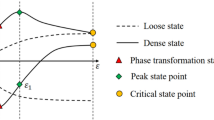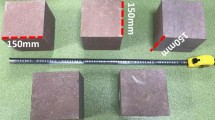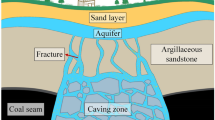Abstract
Interests appear in investigating methane-hydrate-bearing sands (MHBS) to address engineering problems, such as foundation instability of man-made permafrost facilities, wellbore instability and sanding during production. Mechanical behavior of MHBS is critical issue to analyze geomechanical hazards. In this paper, MHBS is synthesized in laboratory and triaxial compressive tests are carried out to capture mechanical response. A discrete element method (DEM) model is developed to examine mechanical responses of MHBS by considering real MHBS-based microstructure and particles contact. To describe nonlinear mechanical behavior, Duncan–Chang model is embedded into DEM model and verified with experimental results. Triaxial drained and undrained numerical tests are carried out to investigate effects of hydrate saturation, confining stress, heterogeneity and grading properties on mechanical behavior of pore-filling hydrate sediment. Experimental and numerical results indicate that (1) triaxial compression strength increases with confining stress and hydrate saturation; (2) stress–strain curve becomes smooth at a higher hydrate saturation thanks to the stability enhancement of MHBS structure; (3) heterogeneous distribution of hydrates leads to local instability with non-bonded hydrate particles; (4) grading properties (uniformity coefficient and mean particle diameter) non-apparent influence on compressive strength and dilatancy due to particles re-distribution; and (5) MHBS presents mechanical behavior of brittleness or plasticity in undrained tests rather than strain softening in drained tests. Except for Duncan–Chang model parameters fitting in this work, more experimental and numerical researches are expected to improve the performance in predicting post-failure behavior.







































Similar content being viewed by others
Abbreviations
- λ :
-
Reaction coefficient
- m w :
-
Mass of water required to prepare MHBS of saturation, kg
- S h :
-
Hydrate saturation
- ρ :
-
Density of methane hydrate
- σ 3 :
-
Confining stress, MPa
- σ 1 :
-
Axial stress, MPa
- σ 1 − σ 3 :
-
Deviatoric stress, MPa
- ε :
-
Axial strain
- a, b :
-
Fitted parameters
- E i :
-
Initial secant elastic modulus, GPa
- σ p :
-
Peak strength, MPa
- R f :
-
Damage ratio
- C :
-
Cohesion, MPa
- φ :
-
Internal friction angle, °
- Un :
-
Displacement between two particles, MPa
- Fn :
-
Normal force between two particles, MPa
- Fs :
-
Shear force between two particles, MPa
- Fs max :
-
Maximum shear force between two particles, MPa
- Ks (k s):
-
Contact shear stiffness, MPa
- E c :
-
Apparent modulus, MPa
- k n :
-
Contact normal stiffness, MPa
- R :
-
Particle radius, mm
- d :
-
Density of particle, kg/m3
- f :
-
Friction
- e :
-
Void ratio
- V V :
-
Void volume, mm3
- V s :
-
Sand volume, mm3
- V h :
-
Volume of gas hydrate, mm3
- V tot :
-
Volume of total model, mm3
- V s :
-
Volume of sand, mm3
- E 50 :
-
Secant elastic modulus, MPa
- ε a 50 :
-
Axial strain at which deviatoric stress reaches half value of peak strength
- v 50 :
-
Secant Poisson’s ratio
- ε r 50 :
-
Radial strain at which deviatoric stress reaches half value of peak strength
- D 60 :
-
Diameter at which 60% of sample's mass is comprised of particles with a diameter less than this value, mm
- D 30 :
-
Diameter at which 30% of the sample's mass is comprised of particles with a diameter less than this value, also known as effective particle size, mm
- D 10 :
-
Diameter at which 10% of the sample's mass is comprised of particles with a diameter less than this value, also known as effective particle size, mm
- C u :
-
Uniformity of soil sample
- C c :
-
Overall smoothness of grading curve
- q′, p′ :
-
Effective stress paths under different hydrate saturations
- σ 1 ′ :
-
Effective axial stress, MPa
- σ 3 ′ :
-
Effective confining stress, MPa
References
Yamamoto, K.: Methane hydrate bearing sediments: a new subject of geomechanics. In: The 12th international conference of international association for computer methods and advances in geomechanics. Goa, India. October 1–6. (2008).
Soga, K.; Lee, S.L.; Ng, M.Y.A.; Klar, A.: Characterisation and engineering properties of Methane hydrate soils. In: Proceedings of the 2nd international workshop on characterisation and engineering properties of natural soils. Singapore. November. (2006).
Kvenvolden, K.: A primer on the geological occurrence of gas hydrate. Geol. Soc. Lond. 137, 9–30 (1998)
Wang, F.; Zhao, B.; Li, G.: Prevention of potential hazards associated with marine gas hydrate exploitation: a review. Energies 11(9), 2384 (2018)
Masui, A.; Haneda, H.; Ogata, Y.; Aoki, K.: Effects of methane hydrate formation on shear strength of synthetic methane hydrate sediments. In: Presented at the international offshore and polar engineering conference. Seoul, Korea. June 19–24, (2005).
Miyazaki, K.; Masui, A.; Aoki, K.; Sakamoto, Y.; Tsutomu, Y.; Okubo, S.: Strain-rate dependence of triaxial compressive strength of artificial methane-hydrate-bearing sediment. Int. J. Offshore Polar Eng. 20(04), 256–264 (2010)
Miyazaki, K.; Aoki, K.; Tenma, N.; Sakamoto, Y.; Tsutomu, Y.: Application of nonlinear elastic constitutive model to analysis of artificial methane-hydrate-bearing sediment sample. In: Presented at the ISOPE ocean mining symposium. Maui, Hawaii, USA. June 19–24. (2011).
Hyodo, M.; Li, Y.; Yoneda, J.; Nakata, Y.; Yoshimoto, N.; Nishimura, A.: Effects of dissociation on the shear strength and deformation behavior of methane hydrate-bearing sediments. Mar. Petrol. Geol. 51, 52–62 (2014)
Miyazaki, K.; Yoshihiro, E.; Tenma, N.; Tsutomu, Y.: Effects of particle-size distribution on the viscoelasticity of artificial methane-hydrate-bearing sand. Int. J. Offshore Polar Eng. 25, 112–119 (2015)
Yoneda, J.; Hyodo, M.; Yoshimoto, N.; Nakata, Y.; Kato, A.: Development of high-pressure low-temperature plane strain testing apparatus for methane hydrate-bearing sand. Soils Found. 53, 774–783 (2013)
Waite, W.F.; Winters, W.J.; Mason, D.H.: Methane hydrate formation in partially water-saturated Ottawa sand. Am. Mineral. 89, 1202–1207 (2004)
Hyodo, M.; Nakata, Y.; Yoshimoto, N.; Orense, R.: Shear behaviour of methane hydrate-bearing sand. In: Presented at the international offshore and polar engineering conference. Lisbon, Portugal. July 1–6. (2007).
Miyazaki, K.; Masui, A.; Sakamoto, Y.; Tenma, N.; Tsutomu, Y.: Effect of confining pressure on triaxial compressive properties of artificial methane hydrate bearing sediments. In: Presented at the Annual Offshore Technology Conference. Houston, Texas, USA. May 3–6 (2010).
Zhang, X.; Wang, S.Y.; Li, Q.P.; Zhao, J.; Wang, A.L.: Experimental study of mechanical properties of gas hydrate deposits. Yantu Lixue/Rock Soil Mech. 31, 3069–3074 (2010)
Yan, R.; Wei, C.; Fu, X.; Zhong, X.; Xiao, G.: Influence of occurrence mode of hydrate on mechanical behaviour of hydrate-bearing soils. Yanshilixue Yu Gongcheng Xuebao/Chin. J. Rock Mech. Eng. 32, 4115–4122 (2013).
Li, Y.; Song, Y.; Yu, F.; Liu, W.; Wang, R.: Effect of confining pressure on mechanical behavior of methane hydrate-bearing sediments. Petrol. Explor. Develop. Online. 38, 637–640 (2011)
Wang, J.; Peng, X.; Liu, L.; Li, Y.; Wang, J.: Multi-hole throttling effect and the erosion characteristics of the high pressure natural gas. Acta Petrol. Sin. (Petrol. Process. Sect.). 34(3), 521–529 (2018).
Sun, C.: Experiment for effect of water-soluble ions on formation of methane hydrate in oil-water emulsion. Oil Gas Storage Transp. 40(7), 791–795 (2021)
Masui, A.; Miyazaki, K.; Haneda, H.; Ogata, Y.; Aoki, K.: Mechanical characteristics of natural and artificial gas hydrate bearing sediments. In: Presented at the 6th international conference on gas hydrates. Goa, India. October 6–10. (2008).
Hyodo, M.; Yoneda, J.; Yoshimoto, N.; Nakata, Y.: Mechanical and dissociation properties of methane hydrate-bearing sand in deep seabed. Soils Found. 53, 299–314 (2013)
Yu, F.; Song, Y.; Liu, W.; Li, Y.; Lam, W.: Analyses of stress strain behavior and constitutive model of artificial methane hydrate. J. Petrol. Sci. Eng. 77, 183–188 (2011)
Yan, C.; Cheng, Y.; Li, M.; Han, Z.; Zhang, H.; Li, Q.; Teng, F.; Ding, J.: Mechanical experiments and constitutive model of natural gas hydrate reservoirs. Int. J. Hydro. Energy. 42, 19810–19818 (2017)
Uchida, S.; Soga, K.; Yamamoto, K.: Critical state soil constitutive model for methane hydrate soil. J. Geophys. Res. Solid Earth. 117 (2012).
Pinkert, S.; Grozic, J.L.H.: Prediction of the mechanical response of hydrate-bearing sands. J. Geophys. Res. Solid Earth. 119, 4695–4707 (2014)
Lin, J.; Seol, Y.; Choi, J.H.: An SMP critical state model for methane hydrate-bearing sands. Int. J. Numer. Anal. Methods Geomech. 39, 969–987 (2015)
Pinkert, S.: Rowe’s stress-dilatancy theory for hydrate-bearing sand. Int. J. Geomech. 17, 06016008 (2017)
Zhang, X.; Lin, J.; Lu, X.; Liu, L.; Liu, C.; Li, M.; Su, Y.: A hypoplastic model for gas hydrate-bearing sandy sediments. Int. J. Numer. Anal. Methods Geomech. 42, 931–942 (2018)
Behseresht, J.; Prodanovic, M.; Bryant, S.L.; Jain, A.K.; Juanes, R.: Mechanisms by which methane gas and methane hydrate coexist in ocean sediments. In: Presented at the 2008 offshore technology conference. Houston, Texas, USA. May 5–8. (2008).
Brugada, J.; Cheng, Y.P.; Soga, K.; Santamarina, J.C.: Discrete element modelling of geomechanical behaviour of methane hydrate soils with pore-filling hydrate distribution. Granular Matter 12, 517–525 (2010)
Jung, J.; Santamarina, J.; Soga, K.: Stress-strain response of hydrate-bearing sands: Numerical study using discrete element method simulations. J. Geophys. Res. (Solid Earth) 117, 4202 (2012)
Zhang, J.; Zhao, C.; Xiong, Z.: Meso-level simulation of gas hydrate dissociation in low-permeability sediments. Theor. Appl. Mech. Lett. 4, 062002 (2014)
Shen, J.; Chiu, C.F.; Ng, C.W.W.; Lei, G.H.; Xu, J.: A state-dependent critical state model for methane hydrate-bearing sand. Comput. Geotech. 75, 1–11 (2016)
Xu, M.; Song, E.; Jiang, H.; Hong, J.: DEM simulation of the undrained shear behavior of sand containing dissociated gas hydrate. Granular Matter. 18 (2016).
Kreiter, S.; Feeser, V.; Kreiter, M.; Mörz, T.; Grupe, B.: A distinct element simulation including surface tension: towards the modeling of gas hydrate behavior. Comput. Geosci. 11, 117–129 (2007)
Kim, Y.J.; Yun, T.S.: Thermal conductivity of methane hydrate-bearing Ulleung Basin marine sediments: laboratory testing and numerical evaluation. Mar. Petrol. Geol. 47, 77–84 (2013)
Mahabadi, N.; Jang, J.: Relative water and gas permeability for gas production from hydrate-bearing sediments. Geochem. Geophys. Geosyst. 15, 2346–2353 (2014)
Jung, J.: Gas production from hydrate-bearing sediments: geo-mechanical implications. Georg. Instit. Technol. Atlanta USA. (2010).
Vinod, J.S.; Hyodo, M.; Indraratna, B.; Miller, R.K.: DEM modelling of methane hydrate bearing sand. Aust. Geomech. J. 49, 175–182 (2014)
Jiang, M.; Peng, D.; Ooi, J.Y.: DEM investigation of mechanical behavior and strain localization of methane hydrate bearing sediments with different temperatures and water pressures. Eng. Geol. 223, 92–109 (2017)
Yu, Y.; Cheng, Y.P.; Xu, X.; Soga, K.: Discrete element modelling of methane hydrate soil sediments using elongated soil particles. Comput. Geotech. 80, 397–409 (2016)
Zhang, G.; Jiang, J.; Guo, J.; He, Z.; Deng, X.; Zhang, Q.: Qiu, Z: The method of making loosely compacted sand cores. Drlling Fluid Compl. Fluid. 24(01), 23–25 (2007)
Duncan, J.M.; Chang, C.Y.: Nonlinear analysis of stress and strain in soils. J. Soil Mech. Found. Eng. Div. ASCE. (SMS) 96, 1629–1633 (1970)
Kondner, R.L.: Hyperbolic stress-strain response: cohesive soils. J. Soil Mech. Found. Div. 89, 115–144 (1963)
Zhang, F.; Zhu, H.; Zhou, H.; Guo, J.; Huang, B.: Discrete-element-method/computational-fluid-dynamics coupling simulation of proppant embedment and fracture conductivity after hydraulic fracturing. SPE J. 22, 632–644 (2017)
Zhu, H.; Shen, J.; Zhang, F.; Huang, B.; Zhang, L.; Huang, W.; McLennan, J.D.: DEM-CFD modeling of proppant pillar deformation and stability during the fracturing fluid flowback. Geofluids 2018, 1–18 (2018)
Zhu, H.; Shen, J.; Zhang, F.: A fracture conductivity model for channel fracturing and its implementation with Discrete Element Method. J. Petrol. Sci. Eng. 172, 149–161 (2019)
Tohidi, B.; Anderson, R.; Clennell, M.B.; Burgass, R.W.; Biderkab, A.B.: Visual observation of gas-hydrate formation and dissociation in synthetic porous media by means of glass micromodels. Geology 29, 867 (2001)
Matsushima, T.; Saomoto, H.; Matsumoto, M.: Discrete element simulation of an assembly of irregularly-shaped grains: quantitative comparison with experiments. In: Presented at the 16th ASCE engineering mechanics conference. Seattle, USA. July 16–18. (2003).
Coetzee, C.J.: Review: Calibration of the discrete element method. Powder Technol. 310, 104–142 (2017)
Cundall, P.A.; Strack, O.D.L.: A discrete numerical model for granular assemblies. Géotechnique. 29, 47–65 (1979)
Zhou, J.; Huang, H.; Deo, M.: Modeling the interaction between hydraulic and natural fractures using dual-lattice discrete element method. In: Presented at the 49th US rock mechanics/geomechanics symposium. American Rock Mechanics Association: San Francisco, California. June 29-July 1. (2015).
Zhu, H.Y.; Shen, J.D.; Zhang, F.S.; Liu, Q.Y.; McLennan, J.D.: Nonlinear constitutive model and discrete-element-method modeling of synthetic Methane Hydrate sand. In: Presented at the 52nd US rock mechanics/geomechanics symposium. June 17–20. (2018).
Adler, P.M.: Multiphase Flow in Porous Media, 2nd edn. Springer, Berlin, German (1996)
Belkhatir, M.; Schanz, T.; Arab, A.; Della, N.; Kadri, A.: Insight into the effects of gradation on the pore pressure generation of sand–silt mixtures. Geotech. Test. J. 37, 922–931 (2014)
Kokusho, T.; Hara, T.; Hiraoka, R.: Undrained shear strength of granular soils with different particle gradations. J. Geotech. Geoenviron. Eng. 130, 621–629 (2004)
Amirpour Harehdasht, S.; Karray, M.; Hussien, M.N.; Chekired, M.: Influence of particle size and gradation on the stress-dilatancy behavior of granular materials during drained triaxial compression. Int. J. Geomech. 17, 04017077 (2017)
Yang, G.; Yu, T.; Hanlong, L.: Numerical simulation of undrained triaxial test using 3D discrete element modeling. In: Presented at the GeoHunan international conference. Changsha, Hunan, China. June 9–11. (2011).
Zoback, M.D.: Reservoir Geomechanics. Cambridge University Press, Cambridge, United Kingdom (2007)
Winters, W.J.; Waite, W.F.; Mason, D.H.; Dillon, W.P.; Pecher, I.A.: Sediment properties associated with gas hydrate formation. In: Presented at the fourth international conference on gas hydrates. Yokohama Symposia, Yokohama, Japan. May 19–23. (2002).
Bishop, A.W.; Eldin, G.: Undrained triaxial tests on saturated sands and their significance in the general theory of shear strength. Geotechnique 2, 13–32 (1950)
Asaoka, A.; Nakano, M.; Noda, T.: Soil-water coupled behavior of heavily overconsolidated clay near/at critical state. Soils Found. 37, 13–28 (1997)
Ishihara, K.; Takatsu, H.: Effects of over-consolidation and K0 conditions on the liquefaction characteristics of sands. Soils Found. 19, 59–68 (1979)
Tan, B.B.: Geotechnical characterization of sediments from Hydrate Ridge, Cascadia Continental Margin. Massachusetts Institute of Technology, Cambridge, Massachusetts, USA. (2004).
Read, H.E.; Hegemier, G.: Strain softening of rock, soil and concrete: a review article. Mech. Mater. Mech. Mater. 3, 271–294 (1984)
Vaid, Y.; Chern, J.C. Cyclic and monotonic undrained response of saturated sands. In: Presented at the Advances in the Art of Testing Soils Under Cyclic Conditions. Detroit, Michigan, United States October 2. (1985).
Acknowledgements
This work was funded by the National Natural Science Foundation of China (Nos. 52192622, 51874253, U19A2097, U20A202) and the open fund (PLC2021040) of State Key Laboratory of Oil and Gas Reservoir Geology and Exploitation (Chengdu University of Technology).
Author information
Authors and Affiliations
Corresponding author
Rights and permissions
About this article
Cite this article
Zhu, H., Tang, X., Zhang, F. et al. Mechanical Behavior of Methane–Hydrate–Bearing Sand with Nonlinear Constitutive Model. Arab J Sci Eng 47, 12141–12167 (2022). https://doi.org/10.1007/s13369-022-06914-2
Received:
Accepted:
Published:
Issue Date:
DOI: https://doi.org/10.1007/s13369-022-06914-2




